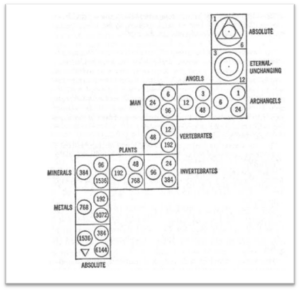Hydrogen
In the system of the Work, the term hydrogen refers to “the basic element or substances of life which are numbered according to what Gurdjieff called their ‘density of vibrations,’ and so can be thought of as higher or lower energies, the higher energies being finer or less dense” (Russell Schreiber, Gurdjieff’s Transformational Psychology: The Art of Compassionate Self-Study, p. 419), each having an assigned numerical value. The term “hydrogen” is not related to the naturally occurring element on the periodic table known as H1. Gurdjieff could have used any word to convey his meaning. Since Hydrogen is the most abundant element in the universe and essential to life, it is a very good placeholder word to be used as a symbol of the great scale of ascending and descending energies in the cosmos, as if from the infinite Absolute God to the infinitesimal quantum quark.
Cosmologically, “a ‘point of the universe’ can be designated by the number of the hydrogen which predominates in it or is central in it” (P.D. Ouspensky, In Search of The Miraculous, p. 170). Hydrogens are related to the idea that every living thing eats food or is eaten, and the numbers assigned represent the level of being of each. Gurdjieff brought this forth in his “Diagram of Everything Living” [also known as the Step Diagram]:

“According to this diagram every kind of creature, every degree of being, is defined by what serves as food for this kind of creature or being of a given level and for what they themselves serve as food because in the cosmic order each class of creature feeds on a definite class of lower creature and is food for a definite class of higher creatures.”
– G.I. Gurdjieff, as quoted by P.D. Ouspensky in In Search of The Miraculous, pp. 322-323.
In the human microcosm, our bodies transform these substances into energies to be used physically, psychologically, and spiritually.
The hydrogen numbering system is also symbolic and representative. The point of the numbering is less about the numeric values and more about conveying the dynamic evolution, development, unfoldment, and doubling of the energies up and down the model of the ray of creation, beginning with fewer orders of laws, 1, and consummating with more orders of laws, 6144. One key point is that the Absolute is under fewer “laws” than all its “emanations.” The Absolute corresponds to the number 1 in part because the Absolute is under no laws other than its own will. Thus, the hydrogens also may correspond not only to the processes of digestion of “food” or influences occurring in the cosmos but also to the number of laws any given level or manifestation functions under. One can ponder also that the hydrogen table begins with the Absolute and completes with the Absolute, conveying the impression that the All and Everything that is the Absolute, from a theological perspective, occurs in, with, through, and as the omnipresence of God, at every level. This also corresponds to the Law of Seven, where the octave begins with Do and completes with Do.
“The work of the factory [human organism] consists in transforming one kind of matter into another, namely, the coarser matters, in the cosmic sense, into finer ones. The factory receives, as raw material from the outer world, a number of coarse ‘hydrogens’ and transforms them into finer hydrogens by means of a whole series of complicated alchemical processes.”
– Ibid, pp. 179-80.
“The centers of the human machine work with different ‘hydrogens.’ …
“The thinking or intellectual center is the slowest of all the three centers … It works with ‘hydrogen’ 48 … The moving center works with ‘hydrogen’ 24. ‘Hydrogen’ 24 is many times quicker and more mobile than ‘hydrogen’ 48. The intellectual center is never able to follow the work of the moving center. We are unable to follow either our own movements or other people’s movements unless they are artificially slowed down. Still less are we able to follow the work of the inner, the instinctive functions of our organism, the work of the instinctive mind which constitutes, as it were, one side of the moving center.
The emotional center can work with ‘hydrogen’ 12. In reality, however, it very seldom works with this fine ‘hydrogen.’… If the emotional center were to work with ‘hydrogen’ 12, its work would be connected with the work of the higher emotional center. In those cases … a temporary connection with the higher emotional center takes place and man experiences new emotions, new impressions hitherto entirely unknown to him, for the description of which he has neither words nor expressions.”
– Ibid, pp. 193-4.